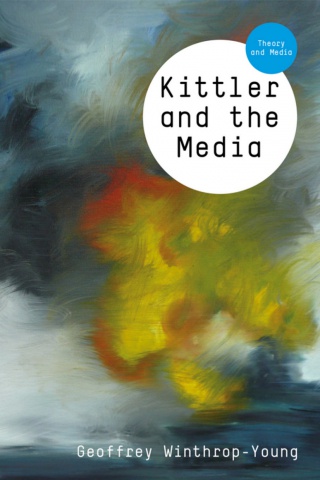Geoffrey Winthrop-Young: Kittler and the Media (2011)
Filed under book | Tags: · alphabet, biography, computing, cultural techniques, discourse, language, media, media technology, media theory, philosophy, technology

“With books such as Discourse Networks and Gramophone, Film, Typewriter and the collection Literature, Media, Information Systems, Friedrich Kittler has established himself as one of the world’s most influential media theorists. He is also one of the most controversial and misunderstood.
Kittler and the Media offers students of media theory an introduction to Kittler’s basic ideas. Following an introduction that situates Kittler’s work against the tumultuous background of German 20th-century history (from the Second World War and the cultural upheaval of the late 1960s to reunification), the book provides succinct summaries of Kittler’s early discourse-analytical work inspired by French post-structuralism, his media-related theorising and his most recent writings on cultural techniques and the notation systems of Ancient Greece.
This clear and engaging overview of a fascinating theorist will be welcomed by students and scholars alike of media, communication and cultural studies.”
Publisher Polity, 2011
Theory and Media series
ISBN 0745644066, 9780745644066
165 pages
PDF (updated on 2019-12-8)
Comments (6)Brian Rotman: Becoming Beside Ourselves: The Alphabet, Ghosts, and Distributed Human Being (2008)
Filed under book | Tags: · affect, alphabet, body, computing, gesture, god, language, mathematics, networks, posthuman, representation, self, semiotics, speech, subjectivity, technology

Becoming Beside Ourselves continues the investigation that the renowned cultural theorist and mathematician Brian Rotman began in his previous books Signifying Nothing and Ad Infinitum…The Ghost in Turing’s Machine: exploring certain signs and the conceptual innovations and subjectivities that they facilitate or foreclose. In Becoming Beside Ourselves, Rotman turns his attention to alphabetic writing or the inscription of spoken language. Contending that all media configure what they mediate, he maintains that alphabetic writing has long served as the West’s dominant cognitive technology. Its logic and limitations have shaped thought and affect from its inception until the present. Now its grip on Western consciousness is giving way to virtual technologies and networked media, which are reconfiguring human subjectivity just as alphabetic texts have done for millennia.
Alphabetic texts do not convey the bodily gestures of human speech: the hesitations, silences, and changes of pitch that infuse spoken language with affect. Rotman suggests that by removing the body from communication, alphabetic texts enable belief in singular, disembodied, authoritative forms of being such as God and the psyche. He argues that while disembodied agencies are credible and real to “lettered selves,” they are increasingly incompatible with selves and subjectivities formed in relation to new virtual technologies and networked media. Digital motion-capture technologies are restoring gesture and even touch to a prominent role in communication. Parallel computing is challenging the linear thought patterns and ideas of singularity facilitated by alphabetic language. Barriers between self and other are breaking down as the networked self is traversed by other selves to become multiple and distributed, formed through many actions and perceptions at once. The digital self is going plural, becoming beside itself.
With a Foreword by Timothy Lenoir
Publisher Duke University Press, 2008
ISBN 0822342006, 9780822342007
176 pages
Commentary (Ben Pritchett, Mute)
Review (Stevan Harnad, Times Literary Supplement)
Sergey Merkurov: Soviet Erotic Alphabet (1931)
Filed under artist publishing | Tags: · alphabet, art, sex

The so-called Sovetskaya eroticheskaya azbuka [Soviet Erotic Alphabet] by the monumentalist sculptor Sergei Dmitrievich Merkurov (1881-1952), the author of numerous monuments to Stalin (including the three largest in the USSR) and Lenin.
Так называемая «Советская эротическая азбука» скульптора-монументалиста Сергея Дмитриевича Меркурова (1881—1952) — автора многочисленных монументов И. В. Сталину (в том числе трех самых крупных на территории СССР) и В. И. Ленину. Знаменитая и крылатая фраза: “В СССР секса нет” имела скорее всего политическую подоплёку. Если самого Лаврентия Берию можно назвать продолжателем дела “секс-машины” Григория Распутина, то, напротив, добропорядочного советского гражданина Сергея Дмитриевича Меркурова, лауреата нескольких сталинских премий, – «строго засекреченным русским Байросом». Данную папку он подписал на обложке: акварельные рисунки И.И. Иванова (1886-1924) и даже указал годы его жизни. Как будто, это имело какое-то значение для работников “карающего меча революции”. Чувствуется сильное влияние французской и южно-немецкой школ живописи.
Commentary: Ross Wolfe (2013)
Erotic Alphabets: A Bibliography (Josh Honn)
Published in 1931
36 pages
via raruss.ru

